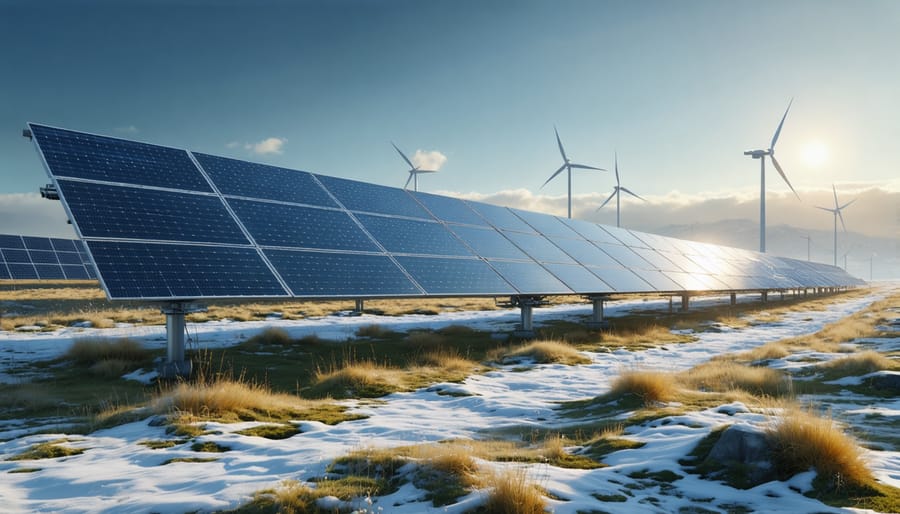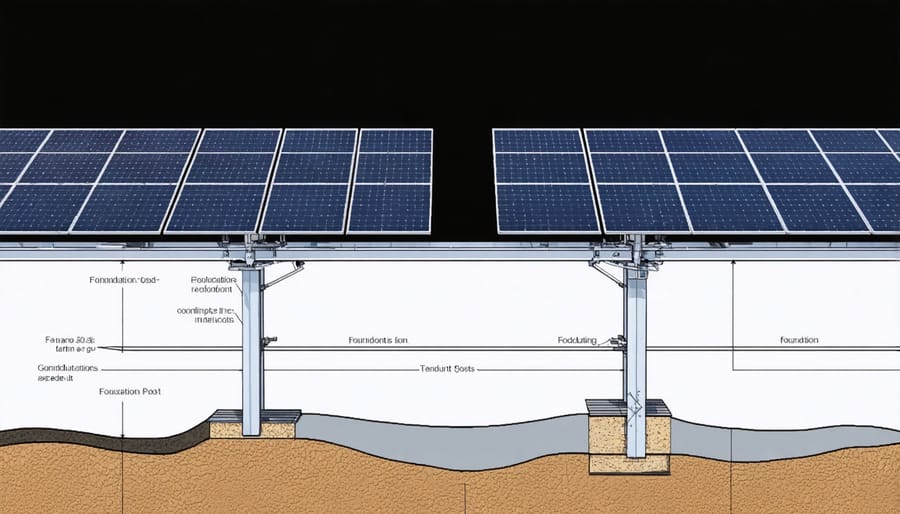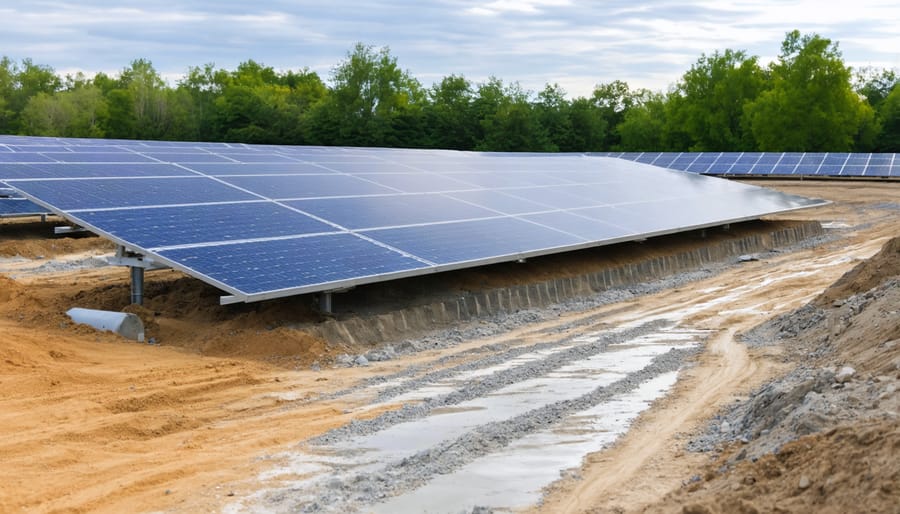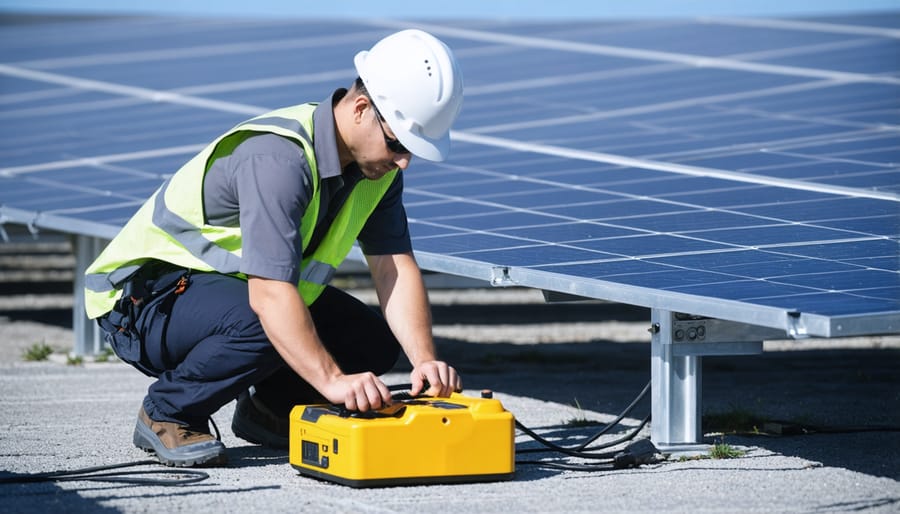Ground Solar Mounting Systems That Withstand European Weather Extremes

Ground-mounted solar systems represent the backbone of Europe’s renewable energy revolution, offering unmatched flexibility and power generation potential for both residential and commercial applications. These robust mounting structures transform unused land into productive energy-generating assets, delivering up to 25% higher efficiency compared to rooftop installations through optimal positioning and enhanced ventilation.
As European nations accelerate their transition to sustainable energy, ground-mounted solar arrays have emerged as a critical solution for meeting ambitious climate targets while navigating complex terrain and diverse weather conditions. From frost-resistant foundations in Nordic regions to wind-resistant designs in coastal areas, modern mounting systems adapt to local environmental challenges while ensuring maximum energy yield.
The latest generation of ground mounting technologies combines innovative engineering with sustainable land use practices, featuring adjustable tilt angles, enhanced structural integrity, and simplified maintenance access. These systems not only comply with stringent European safety standards but also integrate seamlessly with smart monitoring solutions, enabling precise performance tracking and predictive maintenance.
Whether you’re planning a small residential installation or a utility-scale solar farm, understanding the fundamentals of ground mounting systems is essential for maximizing your investment in solar technology while ensuring long-term reliability and compliance with local regulations.

Core Components of European Ground Solar Mounting Systems
Foundation and Support Structures
The foundation and support structures form the crucial backbone of any ground-mounted solar installation, ensuring long-term stability and optimal performance. Different soil conditions across European regions require specific foundation solutions, ranging from concrete foundations to driven piles and ground screws.
For sites with stable, dense soil, concrete foundations provide excellent stability and are particularly common in Central European installations. These typically consist of reinforced concrete blocks or strip foundations that distribute the system’s weight evenly. Ground screws offer a less invasive alternative, particularly suitable for installations in protected landscapes or areas with strict environmental regulations.
The superstructure, typically comprising aluminum or steel mounting options, connects directly to these foundations. The choice of support structure depends on various factors, including local wind loads, snow accumulation, and soil characteristics. In regions with high wind exposure, such as coastal areas, additional reinforcement and deeper foundations may be necessary.
For installations on uneven terrain, adjustable support posts help achieve optimal panel orientation while maintaining structural integrity. These systems often incorporate galvanized steel components for enhanced durability against European weather conditions. Regular geological surveys and soil testing are essential preliminary steps to determine the most suitable foundation type for your specific location.
Rails and Mounting Hardware
The foundation of any reliable ground solar installation lies in its European solar panel mounting frames and rail systems, which must conform to stringent EU standards for durability and safety. Modern rail systems typically feature high-grade aluminium profiles, engineered to withstand diverse weather conditions while providing optimal support for solar panels.
These mounting systems incorporate specially designed clamps and fasteners that ensure secure panel attachment while allowing for thermal expansion and contraction. The rails themselves come in various profiles, with standard lengths of 3.1 to 6.2 meters, offering flexibility for different installation configurations.
Key components include mid-clamps for securing panels between rails, end-clamps for outer panel edges, and splice kits for joining rail sections. The hardware is typically manufactured from corrosion-resistant materials such as stainless steel or anodized aluminium, ensuring longevity in exposed outdoor conditions.
For enhanced stability, the systems feature adjustable brackets that allow for precise levelling on uneven terrain. Load-bearing capacity varies by model, but most systems are designed to handle snow loads up to 5.4 kN/m² and wind speeds up to 130 km/h, meeting requirements across different European climate zones.
Installation efficiency is optimized through pre-assembled components and click-system connections, reducing on-site assembly time while maintaining structural integrity. This modular approach also facilitates future maintenance or system expansion needs.
European Standards and Compliance Requirements
Ground-mounted solar installations in Europe must comply with a comprehensive framework of standards and regulations to ensure safety, reliability, and long-term performance. The primary standard governing these systems is the EN 1991 Eurocode 1, which specifies the structural requirements for withstanding various environmental loads, including wind, snow, and seismic activity.
The IEC 61730 certification is mandatory for all photovoltaic modules used in ground-mounted systems, ensuring electrical safety and mechanical stability. Additionally, the EN 62446 standard outlines the documentation and testing requirements for grid-connected solar installations, providing a systematic approach to system verification and maintenance.
For structural components, manufacturers must obtain CE marking in accordance with the Construction Products Regulation (CPR). This certification confirms that mounting systems meet essential safety requirements and can be legally marketed within the European Economic Area. The EN 1090 standard specifically addresses the execution of steel and aluminium structures, with requirements varying based on execution class and environmental exposure.
Environmental compliance is equally crucial, with installations requiring adherence to local planning regulations and environmental impact assessments. The Environmental Impact Assessment Directive (2014/52/EU) may apply to larger ground-mounted installations, necessitating detailed environmental studies before project approval.
Lightning protection systems must comply with EN 62305, while electrical installations should follow the IEC 60364 series standards. Regular inspection and maintenance protocols, as outlined in EN 62446-2, are essential for maintaining system certification and optimal performance.
For quality assurance, installers should possess relevant certifications such as the European Solar Installation Professional Certification. This ensures proper implementation of safety measures and compliance with installation best practices. Documentation of compliance with these standards is crucial for insurance purposes and may be required for connection to the power grid or accessing renewable energy incentives.
Installation and Site Considerations
Site Assessment and Preparation
Before installing a ground solar mounting system, thorough site assessment and preparation are crucial for optimal performance and longevity. Following established solar panel installation guidelines, the process begins with comprehensive ground analysis to determine soil composition, stability, and drainage characteristics.
The evaluation typically includes geotechnical surveys to assess soil bearing capacity and resistivity testing to ensure proper electrical grounding. These measurements help determine the most suitable foundation type, whether it’s driven piles, ground screws, or concrete foundations. For European climates, frost line depth must be carefully considered to prevent winter damage to the mounting structure.
Terrain evaluation focuses on topography, slope analysis, and potential shading obstacles. The ideal site should have minimal shade from trees, buildings, or geographical features, with a gentle south-facing slope for Northern European installations. Survey teams must also identify underground utilities, drainage patterns, and potential flood zones.
Site preparation requirements include vegetation clearing, ground levelling, and establishing access routes for construction equipment. Proper drainage systems may need installation to prevent water accumulation around mounting structures. In areas with challenging soil conditions, ground reinforcement or soil stabilisation might be necessary.
Environmental considerations are equally important, including protected species habitat assessment and preservation of local flora. Many European jurisdictions require environmental impact studies before ground-mounted solar installations can proceed. Planning should also account for future maintenance access and vegetation management around the array.

Weather Resistance and Load Calculations
Ground-mounted solar installations across Europe face diverse weather challenges, from heavy snow loads in Alpine regions to strong coastal winds along the Atlantic and Mediterranean shores. These environmental factors significantly influence the structural design and load calculations of mounting systems.
A properly engineered ground mount must withstand wind speeds up to 180 km/h in exposed areas and snow loads exceeding 250 kg/m² in mountainous regions. The foundation design typically incorporates a safety factor of 1.5 to account for extreme weather events, ensuring system stability throughout its 25+ year lifespan.
For European installations, structural calculations must comply with Eurocode standards, particularly EN 1991 for actions on structures and EN 1993 for steel structure design. The mounting system’s wind resistance is determined through computational fluid dynamics (CFD) analysis and verified through wind tunnel testing, considering factors such as terrain category, building height, and local topography.
Load distribution calculations account for:
– Dead loads (system weight)
– Live loads (snow, maintenance access)
– Wind loads (uplift, lateral forces)
– Soil conditions and frost depth
– Seismic activity in applicable regions
Modern mounting systems employ advanced engineering features like wind deflectors and reinforced support structures to enhance weather resistance. Regular structural assessments ensure continued compliance with safety standards, particularly in regions experiencing increasing extreme weather events due to climate change.
The mounting system’s design must also consider thermal expansion, with specially engineered components allowing for material contraction and expansion across temperature ranges from -40°C to +85°C, typical for European climate zones.
Maintenance and Long-term Performance

Preventive Maintenance Schedules
Regular maintenance of ground solar mounting systems is essential for ensuring optimal performance and longevity of your solar installation. A comprehensive maintenance schedule should include quarterly visual inspections of all mounting components, with particular attention to structural integrity and proper grounding techniques.
Key maintenance tasks include:
– Monthly cleaning of solar panels and removal of debris
– Quarterly inspection of mounting brackets and fasteners
– Bi-annual torque checks on all bolted connections
– Annual structural assessment of foundation elements
– Seasonal vegetation management around the installation
During inspections, focus on identifying signs of corrosion, loose components, or soil erosion around foundation points. In regions with heavy snowfall, additional winter checks are recommended to ensure the system can handle snow loads. For coastal installations, more frequent inspections may be necessary due to salt air exposure.
Document all maintenance activities in a logbook, including dates, observations, and any corrective actions taken. This documentation is valuable for warranty purposes and helps track the system’s long-term performance. Consider engaging professional maintenance services annually for thorough technical assessments, especially for larger installations.
Prompt attention to minor issues prevents costly repairs and ensures your ground-mounted solar system maintains peak efficiency throughout its operational lifetime.
Performance Monitoring and Optimization
Regular monitoring and optimization of ground solar mounting systems are essential for maximising energy yield and extending system longevity. Modern mounting systems come equipped with sophisticated monitoring solutions that track performance metrics in real-time, including structural integrity, panel orientation, and foundation stability.
Smart sensors integrated into the mounting framework detect ground shifts, excessive snow loads, and potential structural stress points. This data is transmitted to monitoring platforms, allowing system owners to take preventive action before issues escalate. Advanced weather stations connected to the monitoring system help optimize panel tilt angles according to seasonal variations, particularly important in European climates with distinct seasonal changes.
Performance optimization involves regular assessment of several key factors. Ground settlement monitoring ensures the foundation remains stable, while torque verification of mounting components maintains structural integrity. Periodic cleaning schedules, adjusted for local environmental conditions, prevent soil accumulation and vegetation growth that could compromise system efficiency.
Digital mapping tools create detailed performance heat maps, identifying areas where mounting systems might need adjustment or maintenance. This data-driven approach enables precise optimization strategies, from adjusting panel spacing to implementing targeted maintenance protocols.
For enhanced reliability, many European installations now incorporate predictive maintenance algorithms that analyse performance patterns and environmental data to forecast potential issues before they impact system output.
Ground solar mounting systems have proven to be a cornerstone of Europe’s renewable energy transformation, offering robust solutions for both residential and commercial installations. As we’ve explored, these systems provide exceptional stability, optimal energy yield, and adaptability to various terrain conditions across European landscapes.
The future outlook for ground-mounted solar installations in Europe appears particularly promising. With the European Union’s commitment to achieving climate neutrality by 2050, ground-mounted systems are expected to play an increasingly vital role in meeting renewable energy targets. Technological innovations continue to improve system efficiency, with advances in tracking mechanisms and structural designs enhancing overall performance while reducing installation costs.
For property owners and businesses considering solar investment, ground mounting systems offer a compelling combination of durability, maintenance accessibility, and scalability. The growing emphasis on sustainable construction practices and energy independence has positioned these systems as a practical choice for European installations of all sizes.
Looking ahead, we can expect to see further developments in weather-resistant materials, smart monitoring capabilities, and streamlined installation processes. The industry’s focus on sustainability and circular economy principles will likely drive innovations in recyclable components and eco-friendly manufacturing processes.
As European regulations continue to evolve and support renewable energy adoption, ground-mounted solar systems will remain a reliable and future-proof investment for those seeking to harness solar power efficiently and sustainably.
Leave a Reply